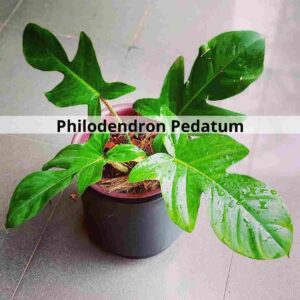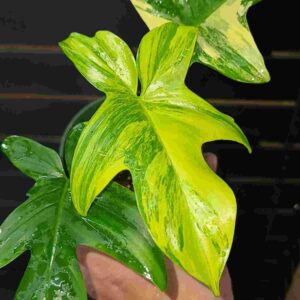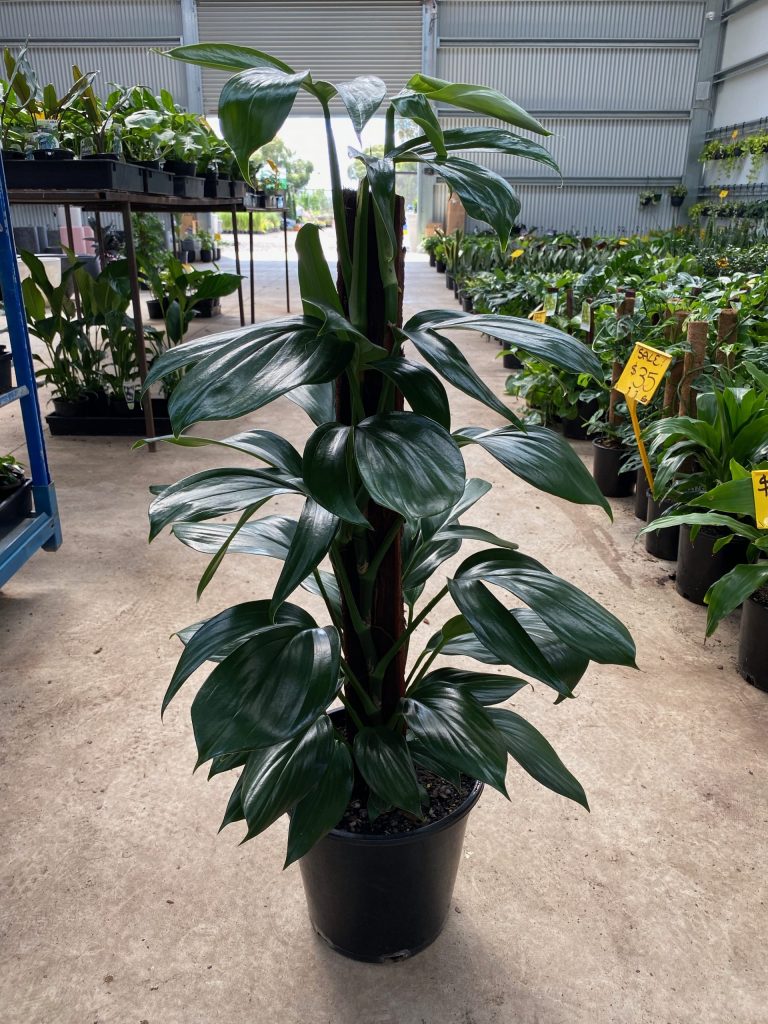Philodendron Pedatum
Philodendron Pedatum is a tropical plant that is not evergreen and is not a perennial. The leaves of the Philodendron Pedatum are large, up to 2 feet long and 1 foot wide, with a heart-shaped base and five lobes.

The flowers are also quite showy, with a pinkish hue. This plant does best when it is used for foliage, rather than flowers. It does well in tropical climates but can be grown in non-tropical areas as well. It has a fast growth rate in proper environment.
Philodendron Pedatum, also known as the Split Leaf Philodendron is a beautiful, fast growing houseplant that is popular among indoor gardeners. Also, it is one of the most popular philodendrons because of its attractive foliage.
The plant originates from tropical America, where it grows as a vine on trees. The scientific name of the plant is Philodendron bipinnatifidum.
Philodendron Pedatum Plant Characters
Philodendron Pedatum is a unique type of philodendron that has stems, leaves and flowers. The leaves are a deep green and the flowers are white with a purple center. This plant does well in both direct and indirect sunlight and can be placed in either moist or dry soil.
It has green stems and leaves and produces small, white flowers. This plant is a good choice for beginner gardeners because it is hardy. Philodendron Pedatum can be grown indoors or outdoors, and makes a beautiful addition to any garden or home decor.
Also Read: Philodendron Selloum (Variegated): Care And Propagation
Philodendron Deja Vu: Care & Propagation
Preferred For Foliage Or Flower
The Philodendron Pedatum is a popular plant for both foliage and flowers. The large leaves are a beautiful green and make a great addition to any room or garden. The flowers are small but numerous and come in shades of pink, red, and white. This plant is easy to care for and can be kept either in direct sunlight or partial shade.
3 Best Places To Keep In Home
One of the best things about this plant is that it can be grown in a variety of different places in your home. Here are three places where you can keep this plant in your room:
1. On the windowsill
The philodendron pedatum does well when it’s placed in direct sunlight. If you have a spot on your windowsill that gets a lot of sun, then this is a great place to put your plant. Just make sure to water it regularly and give it some fertilizer every once in a while.
2. Near a window
The philodendron pedatum does well in indirect sunlight, so placing it near a window is a good option. Just make sure to rotate the plant regularly so that all of the leaves get equal exposure to the sun.
3. On a shelf
If you don’t have a lot of space near your windows, or if you want to move your plant around often, putting it on a shelf is another option. So if you’re looking for a healthy way to improve the quality of your home’s air, consider adding a philodendron pedatum to your indoor garden.
Space Requirement
It grows best when its roots are allowed to spread out and should not be planted in a pot that is too small. A good rule of thumb is to choose a pot size that is at least twice the size of the plant’s root ball.
The stem of the plant is woody and can grow up to 3 feet tall. Although Philodendron Pedatum is not poisonous, it can cause skin irritation if touched.
How Rare Is It?
Philodendron Pedatum is not a common plant, and can be difficult to find in nurseries. If you are lucky enough to find one for sale, expect to pay a high price. This is because the plant is considered to be rare.
These plants are rare because it has a very specific set of growing requirements that are not easy to meet.
It needs warm, humid conditions with high levels of light, and it cannot tolerate cold temperatures or drought. It is also difficult to propagate, so it is not widely available in the horticultural trade.
Is It Invasive?
Some people are concerned that P. Pedatum may be invasive, but there is no evidence that this is the case. P. Pedatum is a beautiful plant that can be grown indoors or outdoors, and it deserves to be more widely known and used.
Philodendron Pedatum Types
Philodendron Pedatum is a popular houseplant because it is easy to care for and has beautiful foliage. It comes in a variety of colors, including
Green
Silver
Pink
There are several types of Philodendron Pedatum, including
The standard type, which has broad leaves
The mini type, which has smaller leaves
The most common type is Philodendron Pedatum ‘Burle Marx’, which has dark green leaves with bright red veins.
This variety is popular for its showy foliage and easy care requirements. Another popular type is Philodendron Pedatum ‘Ricardo’, which has light green leaves with pink veins.
This variety is slower growing than the ‘Burle Marx’ type, but its delicate coloration makes it a favorite among gardeners.
Philodendron pedatum Vs Florida
Philodendron pedatum can be distinguished by its large, heart-shaped leaves with deep lobes. It grows best in moist, well-drained soil and full sun to part shade. It is commonly used as a ground cover or for erosion control.
Florida is home to several species of philodendron, including Philodendron pedatum. Philodendron pedatum is a hardy plant that can tolerate a variety of conditions, making it a popular choice for landscaping in Florida.
Philodendron Pedatum Vs Bipennifolium
The philodendron bipennifolium is a popular houseplant because of its easy care and beautiful foliage. There are many types but the bipennifolium is one of the most common. It has large, heart-shaped leaves that grow up to 18 inches long.
The leaves are a deep green color and have a glossy finish. The philodendron bipennifolium is a fast grower and can quickly fill up a pot.
The philodendron pedatum is another common type of philodendron plant. This plant is also a fast grower, but it has smaller leaves than the bipennifolium.
The leaves of the pedatum are about 6-8 inches long and are a light green color with a matte finish.
Philodendron Pedatum Variegated

Philodendron Pedatum Variegated is a beautiful Philodendron that has green and white leaves that can grow up to 18 inches long. This plant is a great addition to any home or office. It is easy to care for and will grow well in most climates.
Philodendron Pedatum Care
Philodendron Pedatum is a beautiful, hardy plant that can be grown both indoors and outdoors. There are a few things you can do to make sure it thrives.
First, make sure the potting soil is well-drained. Philodendron Pedatum does not like wet feet. You can achieve good drainage by using a pot with drainage holes or by adding pebbles to the bottom of the pot.
Another important thing to remember is to fertilize your plant regularly. Philodendron Pedatum needs fertilizer to stay healthy and grow big leaves. You can use a liquid or granular fertilizer, but make sure it is specifically for plants that grow in shade.
Finally, be sure to give your Philodendron Pedatum plenty of water.
Role of Light and Temperature
In plant biology, the role of light and temperature are two of the most important environmental factors that influence plant growth and development.
Light is necessary for photosynthesis, while temperature affects how quickly plants can grow and how well they can resist pests and diseases.
One common houseplant, Philodendron Pedatum, is a tropical vine that thrives in bright sunlight. In order to grow well, it needs at least six hours of direct sunlight each day. If it doesn’t get enough light, the leaves will start to turn yellow.
Temperature is also important for Philodendron Pedatum. This plant prefers warm temperatures between 65 and 80 degrees Fahrenheit. If the temperature gets too cold, the leaves will start to turn brown.
Water, Humidity and Fertilizers
The Philodendron Pedatum is native to Central and South America. It is a vining plant that grows best in moist environments with high humidity levels. In order to produce lush green leaves and healthy vines, the Philodendron Pedatum requires regular watering and fertilizing.
Training And Pruning
Philodendron Pedatum is a common house plant that grows well with indirect light and weekly watering. This plant is easy to care for and can be trained by pruning its vines to grow in the desired direction. Pruning also helps to keep the plant healthy and looking neat.
Potting And Repotting
When a philodendron begins to outgrow its pot, it is time to repot it into a pot that is one size larger. If the plant is large and has a thick root system, then use a pot that is two sizes larger. When repotting, be sure to use potting soil that is well-draining.
When potting a philodendron, place the root ball in the center of the new pot and fill in around the roots with soil.
Do not pack the soil down; simply firm it lightly so that the plant will be stable.
Philodendron Pedatum Propagation
Philodendron Pedatum is a species of philodendron that is known for its easy propagation and low maintenance requirements.
This plant can be propagated by division or stem cuttings, and it is tolerant of a wide range of growing conditions.
P. Pedatum grows best in moist soil and partial shade, and it can be used as a groundcover or a potted plant.
Philodendron Pedatum is commonly used in the landscape. It is propagated by rooting stem cuttings taken from the current season’s growth.
Rooting success can be improved by taking cuttings from young, vigorous plants and using a rooting hormone.
Cuttings should be planted in a well-drained media and kept moist until they root.
Here is an explanation for this procedure to produce the best results.
- Philodendron Pedatum is a hardy houseplant that can be propagated from stem cuttings taken in late spring or early summer.
- To propagate, take a 6-8 inch cutting from the tip of a healthy stem and remove the leaves from the bottom 2/3 of the cutting.
- Dip the cutting in rooting hormone and plant it in a moistened potting mix.
- Cover the pot with a plastic bag and set it in a warm place until new growth appears.
- When new growth appears, remove the bag and move the pot to a sunny location.
Philodendron Pedatum Price
The price of Philodendron Pedatum varies depending on the size and variety of the plant. Generally, plants range from $8 to $12 each.
Common Problems
There are many pests, diseases and disorders that can affect philodendrons. Some of the more common problems include:
Pests: Spider mites, whiteflies and aphids can all cause damage to philodendrons. They can suck sap from the leaves, causing them to turn yellow or brown and eventually fall off.
Diseases: Fungal diseases such as leaf spot and root rot can be a problem for philodendrons. They can cause the leaves to turn yellow or brown, and in severe cases may lead to plant death.
Disorders: Poor growing conditions such as low light levels or poor soil quality can lead to disorder in philodendrons. This can cause the leaves to become twisted or distorted, and may eventually lead to plant death.
Pros
- A fast growing plant
- Easily fill in spaces in your garden
- A low maintenance plant
- Doesn’t need a lot of watering
- Doesn’t have any major pests or diseases
- A versatile plant
- Easy growth in sun to part shade
Cons
- It needs high humidity to thrive
- It needs bright light but not direct sunlight
- Poisonous if ingested
Conclusion
After a long and arduous study, it has finally been concluded that Philodendron Pedatum is an excellent plant for indoor use. The plant is low-maintenance, and its leaves are poisonous to animals and humans. This makes the Philodendron Pedatum a safe choice for households with pets or small children.




